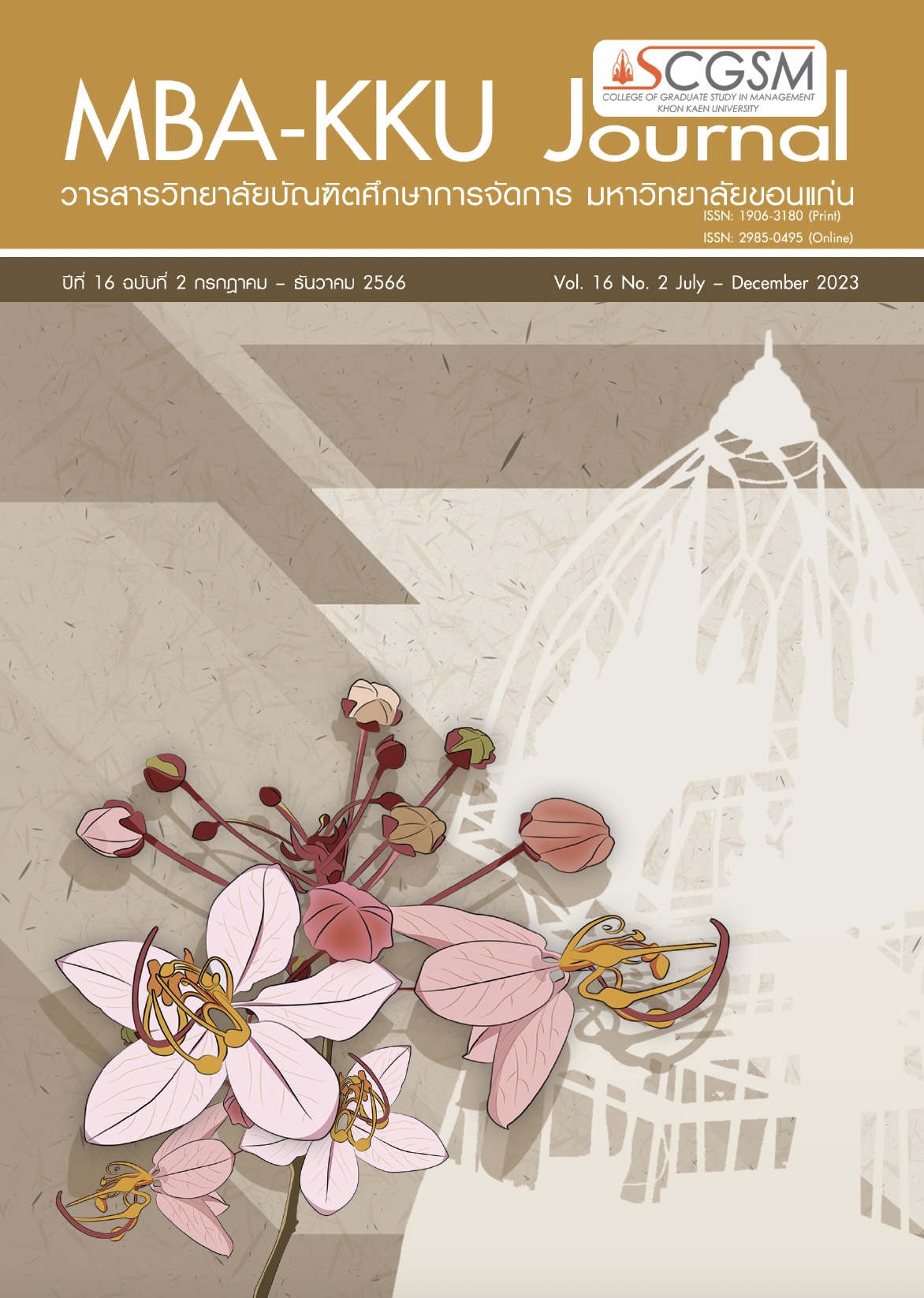Factors Affecting Acceptance of Psychological Service Technology: A Case Study of Telopsychological Online Psychiatric Consultion by Application
Main Article Content
Abstract
This research studied factors affecting acceptance of psychological service technology by Telepsychology application (app) to obtain online psychiatric consultations. Samples were drawn from a private Facebook group and followers of the FB page 1323 Mental Health Consultation. 400 samples respondents had never previously experienced psychiatric consultation by app. Data was collected by online questionnaire and analyzed by descriptive and inferential statistics, including confirmatory component factor analysis and structural equation modeling. Results were that factors positively and directly affecting acceptance of Telepsychology were perceived usefulness, with the highest statistical value of 0.337, and perceived ease of use, at 0.209. Factors with highest positive indirect effect were medical quality, platform system and service quality, in decreasing order of significance. The most influential components were medical accuracy and trust, respectively. Social influence was negatively influential. These findings may serve as guidelines for business product development.
Article Details

This work is licensed under a Creative Commons Attribution-NonCommercial-NoDerivatives 4.0 International License.
- The ideas and opinions expressed in MBA-KKU Journal are those of the authors and not necessarily those of the editor.
- Copyright on any open access article in a journal published by MBA-KKU Journal
References
คณะแพทยศาสตร์ จุฬาลงกรณ์มหาวิทยาลัย. (2565). งานแถลงข่าวเปิดตัวนวัตกรรม DMIND APPLICATION สำหรับคัดกรองผู้ที่มีภาวะซึมเศร้า. ค้นเมื่อ 20 ตุลาคม 2565, จาก https://www.md.chula.ac.th/dmind-application/
บุศรา ดวงบุบผา และประภัสสร วิเศษประภา. (2563). ปัจจัยที่มีผลต่อความตั้งใจใช้บริการปรึกษาปัญหาสุขภาพจิตผ่านช่องทางออนไลน์. วิทยานิพนธ์ปริญญามหาบัณฑิต สาขาวิชาบริหารธุรกิจ คณะบริหารธุรกิจ มหาวิทยารามคำแหง.
พัชราวดี เลิศปัญญาพล. (2563). ความตั้งใจในการใช้บริการแอปพลิเคชันโทรเวชกรรม. วิทยานิพนธ์ปริญญามหาบัณฑิต. สาขาวิชาระบบสารสนเทศเพื่อการจัดการ คณะพาณิชยศาสตร์และการบัญชี มหาวิทยาลัยธรรมศาสตร์.
พัทธนันท์ มารียาห์ แสงกุหลาบ. (2561). การยอมรับเทคโนโลยีสุขภาพ กรณีศึกษา ระบบ Health Service Search. วิทยานิพนธ์ปริญญามหาบัณฑิต สาขาวิชาการบริหารเทคโนโลยี วิทยาลัยนวัตกรรม มหาวิทยาลัยธรรมศาสตร์.
แพทยสภา. (2563). แนวทางปฏิบัติการแพทย์ทางไกลหรือโทรเวช (telemedicine) และคลินิกออนไลน์. ค้นเมื่อ 22 พฤษภาคม 2566, จาก https://tmc.or.th/index.php/News/News-and-Activities/Telemedicine#:~:text =“โทรเวช”%20หรือ%20“การ,หรือบุคคลอื่นใด%20เพื่อ
ศักดา สถิรเรืองชัย. (2556). การรักษาความลับของผู้ป่วย. เวชบัณทึกศิริราช, 6(2), 78-83.
สถาบันสุขภาพจิตเด็กและวัยรุ่นราชนครินทร์. (2563). มาตรฐานการปรึกษาเชิงจิตวิทยาทางเทคโนโลยี : การทบทวนวรรณกรรมอย่างเป็นระบบ. กรมสุขภาพจิต กระทรวงสาธารณสุข.
สำนักงานกองทุนสนับสนุนการสร้างเสริมสุขภาพ. (2563). แค่เครียดหรือซึมเศร้า. ค้นเมื่อ 20 ตุลาคม 2565, จาก https://resourcecenter.thaihealth.or.th/files/66/thaihealth%20watch_แค่เครียด%20หรือ%20ซึมเศร้า.pdf
เริงฤทธิ์ พลเหลือ. (2563). ปัจจัยความสัมพันธ์เชิงสาเหตุที่ส่งผลต่อการตัดสินใจเลือกใช้งานแอปพลิเคชันปรึกษาแพทย์. วิทยานิพนธ์ปริญญามหาบัณฑิต สาขาวิชาการบริหารธุรกิจ บัณฑิตวิทยาลัย มหาวิทยาลัยกรุงเทพ.
วรัณญา สิทธิมั่นคง. (2563). การยอมรับเทคโนโลยีและความตั้งใจใช้ TELEMEDICINE ในกรุงเทพมหานครและปริมณฑล. วิทยานิพนธ์ปริญญามหาบัณฑิต สาขาวิชาการบริหารการตลาดคณะพาณิชยศาสตร์และการบัญชี มหาวิทยาลัยธรรมศาสตร์.
วิภาวัณย์ อรรณพพรชัย และชวภณ กิจหิรัญกุล. (2564). การประยุกต์ใช้ระบบการแพทย์ทางไกลเพื่อการพัฒนาคุณภาพการให้บริการ ทางการแพทย์ฉุกเฉินทางไกลในชนบท. วารสารวิจัยมหาวิทยาลัยเวสเทิร์น มนุษยศาสตร์และสังคมศาสตร์, 7(3), 258-271.
อธิบ ต้นอารีย์, นิศากร แก้วพิลา, เบ็ญจา นิ่มนวล, เศรษฐพงศ์ บุญหมั่น, ลวิญญ์วิชญพงศ์ ภูมิจีน, และณัฏฐพัชร สุนทโรวิทย์ (2560). การรับบริการสุขภาพจิตและสาเหตุที่ไม่เข้ารับบริการสุขภาพจิตของผู้ป่วยจิตเวชไทย Mental health service utilization and reason for not receiving services among individuals with mental disorders. วารสารสุขภาพจิตแห่งประเทศไทย, 25(3), 175-186.
องค์การยูนิเซฟ ประเทศไทย. (2563). ยูนิเซฟและกรมสุขภาพจิตชี้โควิด-19 ส่งผลให้สุขภาพจิตเด็กและวัยรุ่นไทยย่ำแย่อย่างต่อเนื่อง. ค้นเมื่อ 20 ตุลาคม 2565, จาก https://www.unicef.org/thailand/th/press-releases/ยูนิเซฟและกรมสุขภาพจิตชี้โควิด-19
Asch, S.E. (1952). Group forces in the modification and distortion of judgments. ค้นเมื่อ 22 พฤษภาคม 2566, จาก http://psycnet.apa.org/record/2004-16341-016
Bollen, K A., & Long, S. J. (1993). Testing Structural Equation Models. SAGE Focus Edition, vol. 154. Retrieved March 18, 2010, from http://en.wikipedia.org/wiki/Structural_equation_modeling#cite_note-3
DeLone, W.H. & McLean, E.R. (2003). The DeLone and McLean Model of Information Systems Success: A Ten-Year Update. Journal of Management Information Systems, 19(4), 9-30. doi.org/10.1080/07421222.2003.11045748.
Grigsby, J., Kaehny, M.M., Sandberg, E.J., Schlenker, R.E., & Shaughnessy, P.W. (1995). Effects and Effectiveness of Telemedicine. Health Care Financing Review are provided here courtesy of Centers for Medicare and Medicaid Services, 17(1), 115–131.
Lindeman, R.H., Merenda, P.F., & Gold, R. Z. (1980). Introduction to bivariate and multivariate analysis. Glenview, Illinois: Scott, Foresman and Company. อ้างถึงใน จิตตานันท์ ติกุล. (2547). การพัฒนาโมเดลเชิงสาเหตุความมีวินัยในตนเองของนักศึกษาระดับปริญญาตรี มหาวิทยาลัยเทคโนโลยีสุรนารี: การวิเคราะห์กลุ่มพหุ. วิทยานิพนธ์มหาบัณฑิต ภาควิชาวิจัยการศึกษา คณะครุศาสตร์ จุฬาลงกรณ์มหาวิทยาลัย.
Ragda, M., Mohamed, N., & Sahar H. (2020). Acceptance of Telemedicine and E-Health Applications in Developing Countries. International Conference on Computer, Control, Electrical, and Electronics Engineering (ICCCEEE). Conference Location: Khartoum, Sudan DOI:10.1109/ICCCEEE49695.2021.9429558
Steffi, A., Putu, W., & Handayani, F.A. (2021). Indonesian hospital telemedicine acceptance model: the influence of user behavior and technological dimensions. https://doi.org/10.1016/j.heliyon.2021.e08599.
Venkatesh, V., Morris, M. G., Davis, G. B., & Davis, F. D. (2003). User Acceptance of Information Technology: Toward a Unified View. MIS Quarterly, 27(3), 425-478. doi:10.2307/30036540


